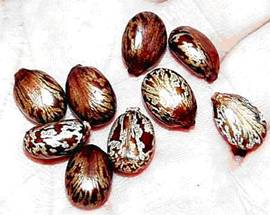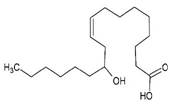
Therapeutic castor oil is cold-pressed from the small, thick round seeds of the tropical castor bean plant (Ricinus Communis L., Euphorbiaceae). The oil comprises 60% of the seed and is rich with ricinolein, a glyceride of ricinoleic acid.

What's in a name? CO was known to the Greeks as Kiki and to the Romans as "Palma Christi" (the leaves of the castor bean plant were thought to resemble the palm of Christ. Indeed, this name beautifully reflects the inherent healing power of this unique oil). Beginning in the 17th century, CO was taken internally for its effect as an "irritant" or "stimulant" to cleanse the digestive tract, however, its ingestion is no longer recommended.
Castor oil is applied externally. In the early 20th century, Edgar Cayce recommended castor oil packs as an external application over the right side of the abdomen for a variety of conditions. CO packs are used successfully to help increase eliminations, stimulate the liver and gallbladder, and to alleviate various kinds of abdominal complaints, headaches, inflammatory conditions, pains, muscle damage, skin eruptions and lesions.
|
Rare RICINOLEIC ACID is main ingredient of castor OIL (CO)  CO has minor components of oleic and linoleic acids, but close to 90% of its fatty acids are RICINOLEIC ACID (RA). Rare in the plant kingdom, and believed to be responsible for CO's remarkable healing abilities. RA has been shown to prevent growth of numerous species of viruses, bacteria, yeasts and molds. RA (C18H34O3) is a monounsaturated fatty acid produced in CO by hydroxylation of oleic acid. It is an omega-9 (C=C double bond in w9 position), 18-carbon fatty acid having a hydroxyl functional group at the 12th carbon, a very uncommon property for a biological fatty acid. This functional group causes RA (and therefore castor oil) to be unusually polar, and also allows chemical derivatives not practical with other biological oils. Polar molecules include ammonia and glucose and are generally able to dissolve in water due to the polar nature of water -"like dissolves like". Polar molecules have slightly positive and slightly negatively charged ends (Non-polar compounds include fats, oil and petrol).
|
CO used as a Thickener and Emulsifier. Acts as a water dispersant to help oil-based ingredients mix into water-based ingredients.
Humectant. Soothing and emollient (seals in moisture)
Boosts lather in handcrafted soaps
Provides incredible slip